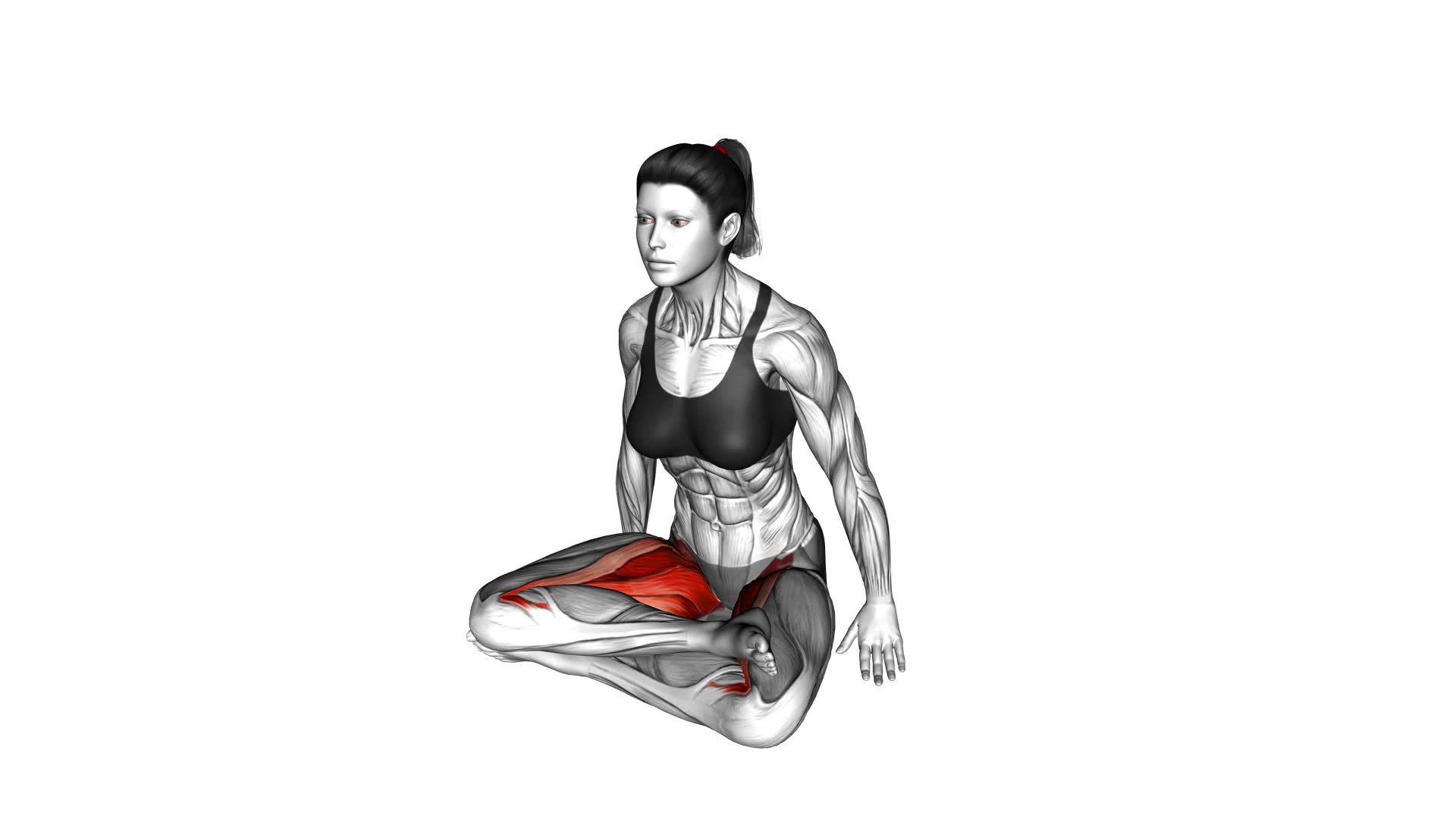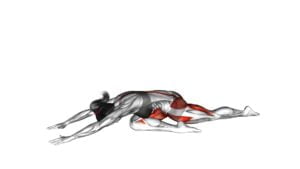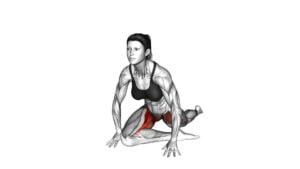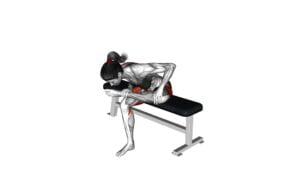Double Pigeon Pose (female) – Video Exercise Guide & Tips

Looking to improve your flexibility and find inner peace?
Watch This Exercise Video
Double Pigeon Pose, a popular yoga pose, is here to help. In this video exercise guide, we'll show you how to properly perform Double Pigeon Pose, along with helpful tips to deepen your practice.
Whether you're a beginner or an experienced yogi, this pose can bring numerous benefits to your mind, body, and soul.
So grab your mat, hit play, and let's get started on this journey to tranquility.
Key Takeaways
- Double Pigeon Pose stretches the outer hips and glutes.
- It alleviates tightness and tension in the hip muscles.
- The pose improves posture by opening up the hips and releasing tension in the lower back.
- Double Pigeon Pose increases flexibility in the hip joints and relieves tightness in the lower back.
Benefits of Double Pigeon Pose
Discover the numerous benefits of practicing Double Pigeon Pose to improve flexibility and release tension in your hips and lower back.
Double Pigeon Pose, also known as Firelog Pose or Agnistambhasana, is a seated yoga pose that targets the external rotation of the hips. This pose helps to open up the hips, increase flexibility in the hip joints, and relieve tightness in the lower back.
One of the main benefits of Double Pigeon Pose is that it stretches the outer hips and glutes. By crossing one leg over the other and stacking the shins, you create a deep stretch in the outer hips. This can help to alleviate tightness and tension in the hip muscles, which is particularly beneficial for individuals who sit for long periods or engage in activities that put strain on the hips.
Additionally, Double Pigeon Pose can help to improve posture by opening up the hips and releasing tension in the lower back. When the hips are tight, it can cause the pelvis to tilt forward, leading to an excessive curve in the lower back. By practicing this pose regularly, you can help to realign the pelvis and improve overall posture.
There are variations and modifications for Double Pigeon Pose that can be used to accommodate different levels of flexibility. For individuals with tight hips, placing a blanket or bolster under the hips can help to elevate the hips and make the pose more accessible. Alternatively, using a strap around the feet can assist in bringing the legs closer to the body.
Preparing for Double Pigeon Pose
To prepare for Double Pigeon Pose, start by finding a comfortable seated position on your mat. It's important to warm up your body before attempting this pose to prevent injury and promote flexibility. Here are some preparation tips and warm-up exercises to get you ready for Double Pigeon Pose.
First, begin with some gentle stretching exercises for your hips and thighs. You can try seated forward folds, butterfly stretches, or reclined pigeon pose to open up your hip joints and increase flexibility.
Next, incorporate some dynamic movements to further warm up your body. This can include leg swings, hip circles, or lunges to activate and engage the muscles in your legs and hips.
Once you feel adequately warmed up, come into a seated position with one leg crossed over the other, stacking your shins on top of each other. Make sure both of your sit bones are grounded on the mat.
It is important to listen to your body and not push yourself beyond your limits. If you experience any discomfort or pain, modify the pose or try an alternative stretch.
Step-by-Step Guide to Double Pigeon Pose
To ensure proper alignment in Double Pigeon Pose, there are a few key points to keep in mind.
First, make sure to sit evenly on your sitting bones and stack your knees on top of each other.
Secondly, flex your feet to protect your ankles and engage your leg muscles.
Finally, maintain an upright posture and lengthen your spine to avoid rounding or straining your back.
Alignment Tips for Pose
Sit tall with your legs crossed, placing your right ankle on top of your left knee, to achieve proper alignment in Double Pigeon Pose. To ensure you're in the correct position, follow these alignment cues:
- Keep your sitting bones grounded and evenly distributed on the mat.
- Flex your feet to protect your ankles and knees.
- Lengthen your spine, lifting your chest and drawing your shoulder blades down and back.
If you find it challenging to maintain proper alignment, you can use props for support. Consider using a yoga block or folded blanket under your sitting bones to elevate your hips and ease any discomfort in your hips or knees.
Common Mistakes to Avoid
When practicing Double Pigeon Pose, it's important to be aware of common mistakes and how to avoid them. One common mistake is rounding the spine instead of sitting up tall. To maintain proper form, engage your core and lengthen through your spine.
Another mistake is placing the top ankle on the knee instead of the thigh, which can strain the knee joint. Ensure that the ankle is resting on the thigh to protect your knees.
Additionally, avoid forcing yourself into the pose if you feel pain or discomfort. Listen to your body and modify the pose as needed.
By being mindful of these common mistakes and maintaining proper form, you can make the most of your Double Pigeon Pose practice.
Now, let's move on to explore modifications and variations for Double Pigeon Pose.
Modifications and Variations for Double Pigeon Pose
To modify Double Pigeon Pose, you can use a chair to support your hips if sitting on the floor is uncomfortable. Placing a blanket under your knees can provide extra cushioning and support.
Another variation is the Half Lotus pose, where one foot is placed on top of the opposite thigh instead of both feet being stacked on top of each other.
These modifications and variations can help make Double Pigeon Pose more accessible and comfortable for your practice.
Chair Modification Option
Try modifying the Double Pigeon Pose by using a chair for added support and stability. This chair modification option is especially beneficial for individuals who may struggle with knee alignment or have limited flexibility. Here are three key benefits of using a chair for the Double Pigeon Pose:
- Improved knee alignment: Placing your legs on the chair helps to align your knees properly, reducing the risk of strain or injury.
- Increased stability: The chair provides a sturdy base, allowing you to maintain balance and stability throughout the pose.
- Enhanced accessibility: Using a chair makes the Double Pigeon Pose more accessible for individuals who may find the traditional variation challenging.
Blanket for Knee Support
To provide additional support and cushioning for your knees in the Double Pigeon Pose, utilize a blanket underneath them. This modification is especially beneficial for those who experience knee pain or discomfort during the pose.
By placing a blanket under your knees, you can alleviate pressure on the joints and provide a more comfortable experience. The blanket helps to distribute your body weight evenly, reducing the strain on your knees and allowing for proper alignment.
It also provides a soft surface that can help prevent any discomfort caused by direct contact with the floor. Remember to adjust the thickness of the blanket to suit your needs and ensure that you maintain proper alignment throughout the pose for maximum knee pain relief.
Half Lotus Variation
You can modify and vary the Double Pigeon Pose by incorporating the Half Lotus Variation. This variation provides additional hip opening stretches and allows for deeper engagement in the pose.
Here are three modifications you can try:
- Half Lotus Variation with a Prop: If your hips are tight, you can place a blanket or bolster under your elevated leg to support it and reduce strain on the knee.
- Half Lotus Variation with a Twist: To further engage your core and stretch your spine, try adding a gentle twist by placing your opposite hand on the ground behind you and twisting towards your elevated leg.
- Half Lotus Variation with Forward Fold: For a deeper stretch in your hips and hamstrings, fold forward over your legs while keeping your spine long. You can use a yoga block or bolster for support if needed.
Tips for Deepening Your Double Pigeon Pose
Enhance the depth of your Double Pigeon Pose with these effective strategies.
To stay balanced in Double Pigeon Pose, start by sitting on a folded blanket or bolster to elevate your hips. This will help you maintain stability and prevent any strain on your knees.
Engage your core muscles to support your spine and keep your body aligned.
When it comes to breathing deeply in Double Pigeon Pose, focus on inhaling deeply through your nose and exhaling fully through your mouth.
As you inhale, imagine filling your lungs with air and expanding your ribcage.
As you exhale, allow any tension or tightness in your body to release.
This will help you relax into the pose and deepen your stretch.
It's important to listen to your body and only go as far as feels comfortable for you.
If you feel any pain or discomfort, back off and modify the pose by using props, such as blocks or blankets, to support your hips and knees.
Remember to always honor your limits and practice patience as you work towards deepening your Double Pigeon Pose.
With consistent practice and proper alignment, you'll gradually increase your flexibility and find greater ease in this pose.
Safety Precautions and Common Mistakes to Avoid
When deepening your Double Pigeon Pose, it's important to be aware of safety precautions and common mistakes to avoid. Practicing correct form and taking steps to prevent injuries will ensure a safe and effective practice. Here are three key points to keep in mind:
- Alignment: Maintaining proper alignment is crucial to avoid strain on your joints and muscles. Make sure to sit evenly on your sitting bones, with your spine straight and shoulders relaxed. Keep your hips squared and level, and avoid leaning to one side or rounding your back. Engage your core to support your posture throughout the pose.
- Flexibility: Double Pigeon Pose requires a good amount of hip flexibility. If you feel any discomfort or pain in your knees or hips, it's important to modify the pose to suit your level of flexibility. Use props like blankets or blocks to elevate your hips if needed, and gradually work towards a deeper stretch over time.
- Gradual Progression: It's essential to progress gradually in your practice to avoid overstretching or straining your muscles. Listen to your body and honor its limits. If you feel any pain or discomfort, ease off the pose and make adjustments. Remember that the journey towards a deeper Double Pigeon Pose is a gradual process, and it's important to be patient and kind to yourself along the way.
Frequently Asked Questions
What Are the Benefits of Double Pigeon Pose for Pregnant Women?
During pregnancy, practicing double pigeon pose can offer several benefits. This pose helps open the hips, stretch the glutes and lower back, and improve overall flexibility.
However, it's important for pregnant women to take certain precautions and modifications. Prenatal yoga modifications for double pigeon pose include using props for support, avoiding deep forward folds, and listening to your body's limits.
Always consult with your healthcare provider before starting any exercise routine during pregnancy.
Can Double Pigeon Pose Help Alleviate Lower Back Pain?
Double pigeon pose is a great stretch for your hips and lower back. It can help alleviate lower back pain by opening up tight hip muscles and improving flexibility. To get the most out of this pose, make sure to properly align your legs and sit bones. If you're experiencing discomfort, try using modifications like sitting on a blanket or placing blocks under your knees. Take it slow and listen to your body's limits.
Are There Any Specific Breathing Techniques to Follow During Double Pigeon Pose?
During double pigeon pose, it's important to pay attention to your breath. By focusing on deep inhales and exhales, you can enhance the benefits of the pose and promote relaxation.
Take slow, steady breaths as you settle into the pose, allowing your body to release tension with each exhale.
Beginners can modify the pose by using props like blankets or blocks to support their hips and ease any discomfort.
Remember to listen to your body and adjust as needed.
Can Double Pigeon Pose Help Improve Flexibility in the Hips and Groin Area?
Double Pigeon Pose is great for improving flexibility in the hips and groin area. It helps to open up tight muscles and release tension.
To properly align your body in this pose, sit on the floor with your legs crossed, stacking one shin on top of the other. Keep your spine straight and engage your core. Avoid common mistakes like rounding your back or forcing your knees down.
Practice regularly to see progress in your flexibility.
Are There Any Alternative Poses or Exercises That Can Provide Similar Benefits to Double Pigeon Pose?
Looking for alternative poses or exercises to double pigeon pose? You're in luck! There are several options that can provide similar benefits.
Modifying double pigeon pose is a great way to ease into it. You can also try variations of pigeon pose, such as reclined pigeon or one-legged pigeon.
Additionally, there are plenty of other hip-opening exercises like butterfly stretch or happy baby pose that can help improve flexibility in the hips and groin area.
Conclusion
In conclusion, double pigeon pose is a beneficial yoga pose that can help improve flexibility, release tension in the hips, and promote relaxation.
By following the step-by-step guide and incorporating modifications and variations, you can customize the pose to suit your needs and abilities.
Remember to listen to your body, avoid common mistakes, and prioritize safety to fully enjoy the benefits of this pose.
With practice and dedication, you can deepen your double pigeon pose and enhance your overall yoga practice.

Author
Years ago, the spark of my life’s passion ignited in my mind the moment I stepped into the local gym for the first time. The inaugural bead of perspiration, the initial endeavor, the very first surge of endorphins, and a sense of pride that washed over me post-workout marked the beginning of my deep-seated interest in strength sports, fitness, and sports nutrition. This very curiosity blossomed rapidly into a profound fascination, propelling me to earn a Master’s degree in Physical Education from the Academy of Physical Education in Krakow, followed by a Sports Manager diploma from the Jagiellonian University. My journey of growth led me to gain more specialized qualifications, such as being a certified personal trainer with a focus on sports dietetics, a lifeguard, and an instructor for wellness and corrective gymnastics. Theoretical knowledge paired seamlessly with practical experience, reinforcing my belief that the transformation of individuals under my guidance was also a reflection of my personal growth. This belief holds true even today. Each day, I strive to push the boundaries and explore new realms. These realms gently elevate me to greater heights. The unique combination of passion for my field and the continuous quest for growth fuels my drive to break new ground.







